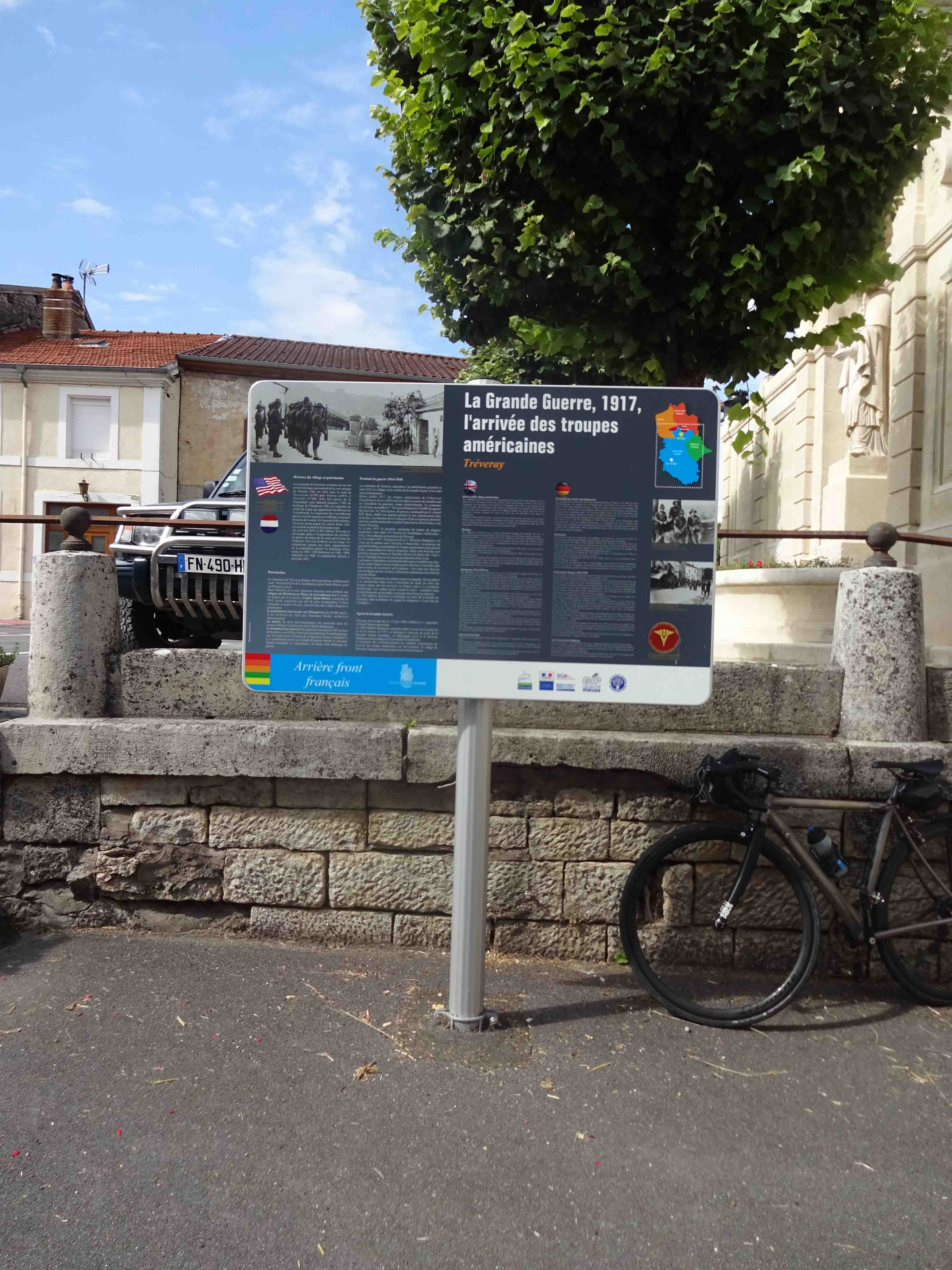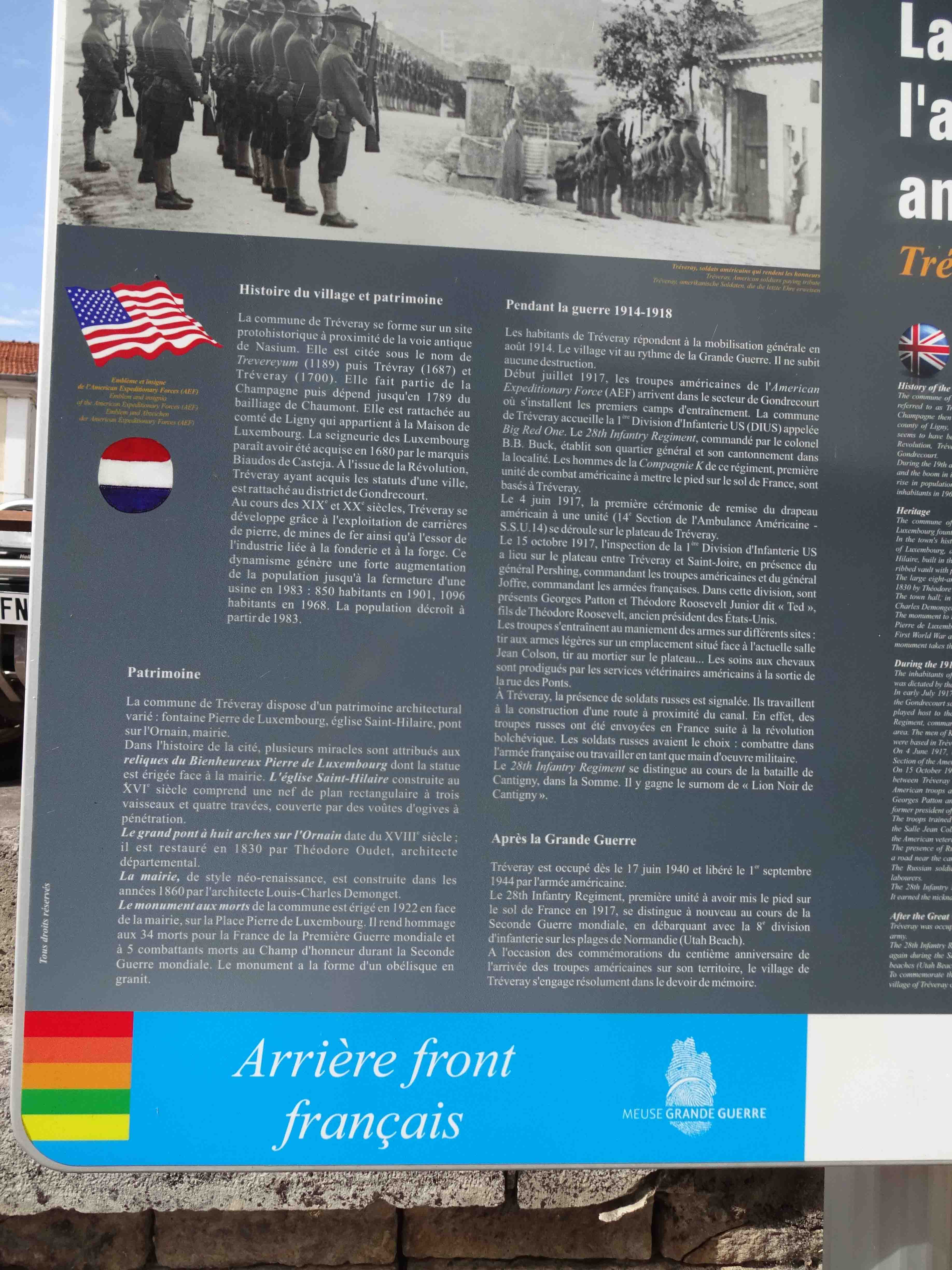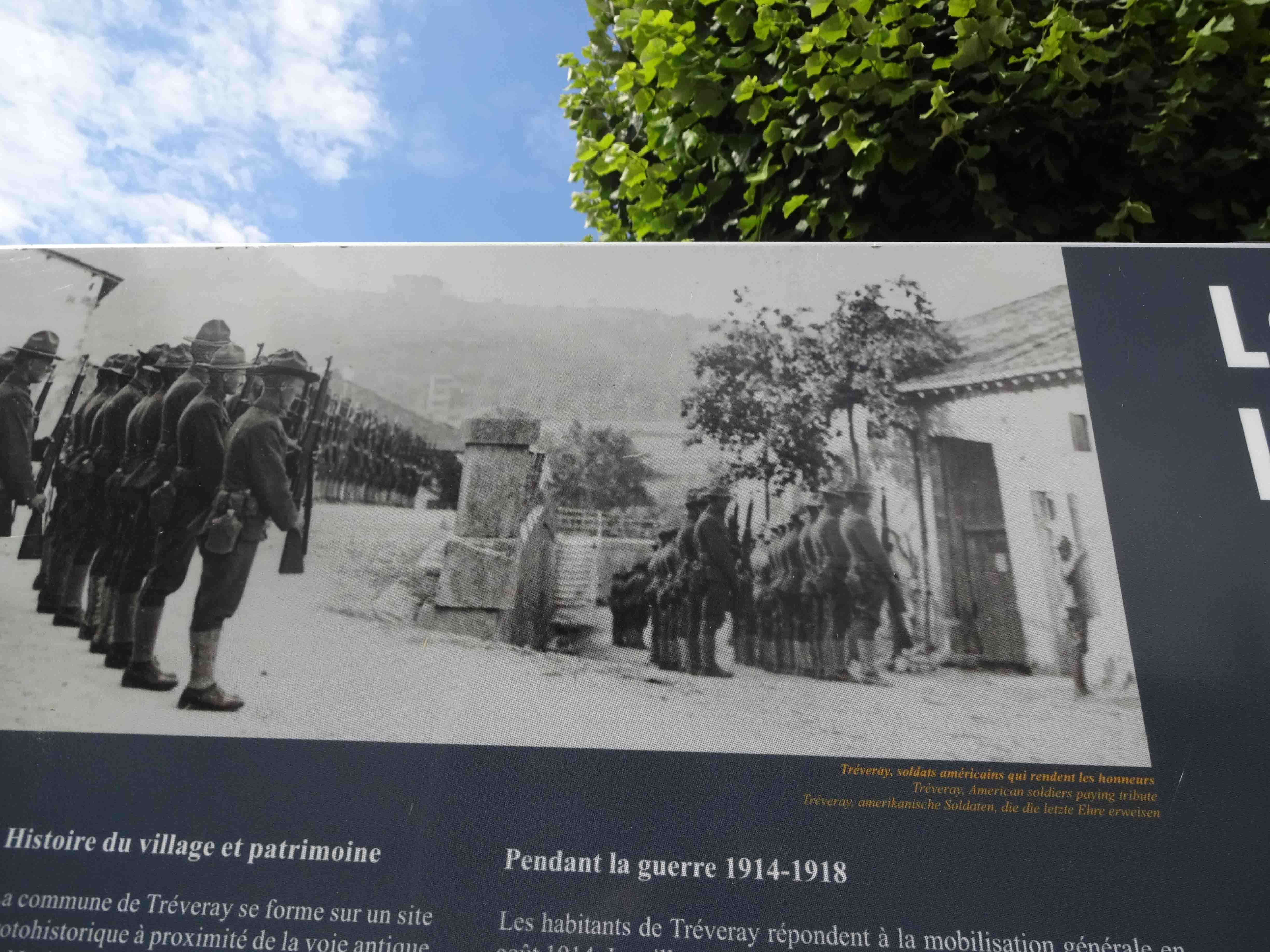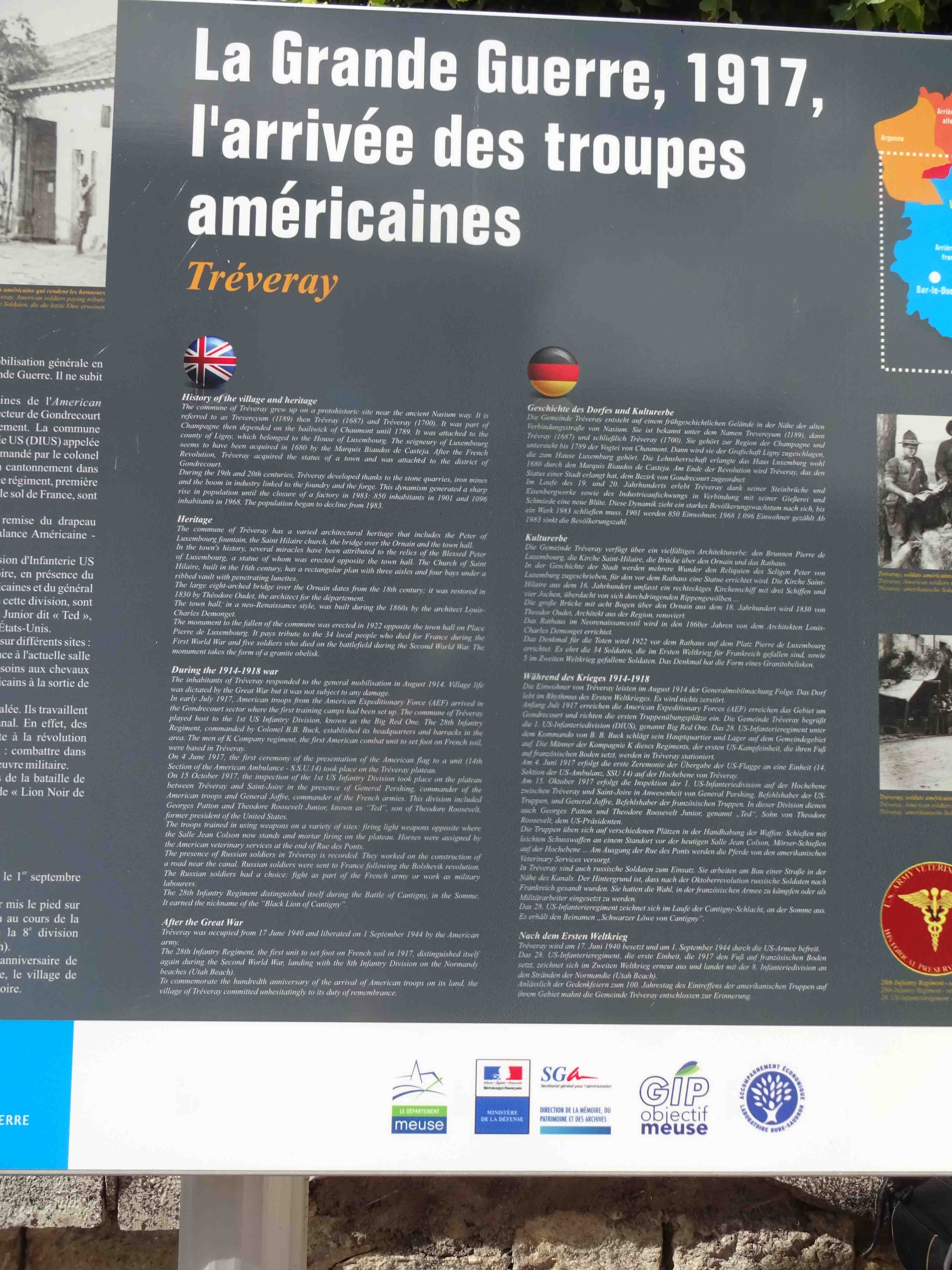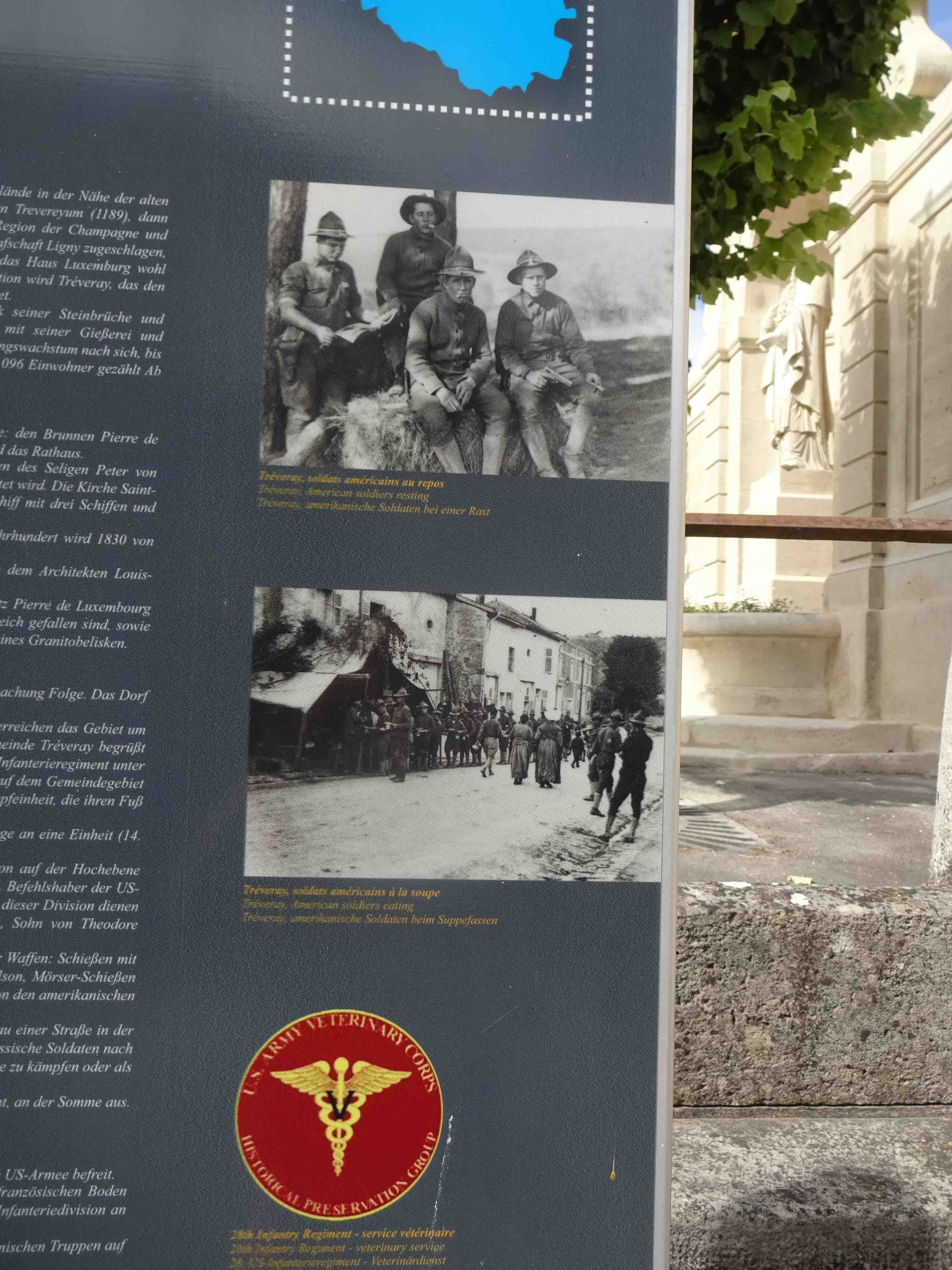La Grande Guerre (WW1) Info Sign Treveray
Details:
On the edge of the road, near the town’s war memorial.
Monument Text:
La Grande Guerre, 1917,
l'arrivée des troupes
américaines
Tréveray
English Translation:
The Great War, 1917
The arrival of the troops
American
Tréveray
(Left column; in French text.)
(-picture-)
Tréveray, soldats américains qui rendent les honneurs
Tréveray, American soldiers paying tribute
Tréveray, amerikanische Soldaten, die die letzte Ehre erweisen
(-Emblem-)
Emblème et insigne
de l'American Expeditionary Forces (AEF)
Emblem and insignia
of the American Expeditionary Forces (AEF)
Emblem und Abzeichen
der American Expeditionary Forces (AEF)
Histoire du village et patrimoine
La commune de Tréveray se forme sur un site protohistorique à proximité de la voie antique de Nasium. Elle est citée sous le nom de Trevereyum (1189) puis Trévray (1687) et Tréveray (1700). Elle fait partie de la Champagne puis dépend jusqu'en 1789 du bailliage de Chaumont. Elle est rattachée au comté de Ligny qui appartient à la Maison de Luxembourg. La seigneurie des Luxembourg paraît avoir été acquise en 1680 par le marquis Biaudos de Casteja. À l'issue de la Révolution, Tréveray ayant acquis les statuts d'une ville, est rattaché au district de Gondrecourt.
Au cours des XIXe et XXe siècles, Tréveray se développe grâce à l'exploitation de carrières de pierre, de mines de fer ainsi qu'à l'essor de l'industrie liée à la fonderie et à la forge. Ce dynamisme génère une forte augmentation de la population jusqu'à la fermeture d'une usine en 1983 : 850 habitants en 1901, 1096 habitants en 1968. La population décroît à partir de 1983.
Patrimoine
La commune de Tréveray dispose d'un patrimoine architectural varié : fontaine Pierre de Luxembourg, église Saint-Hilaire, pont sur l'Ornain, mairie.
Dans l'histoire de la cité, plusieurs miracles sont attribués aux reliques du Bienheureux Pierre de Luxembourg dont la statue est érigée face à la mairie. L'église Saint-Hilaire construite au XVIe siècle comprend une nef de plan rectangulaire à trois vaisseaux et quatre travées, couverte par des voûtes d'ogives à pénétration.
Le grand pont à huit arches sur l'Ornain date du XVIIIe siècle ; il est restauré en 1830 par Théodore Oudet, architecte départemental.
La mairie, de style néo-renaissance, est construite dans les années 1860 par l'architecte Louis-Charles Demonget.
Le monument aux morts de la commune est érigé en 1922 en face de la mairie, sur la Place Pierre de Luxembourg. Il rend hommage aux 34 morts pour la France de la Première Guerre mondiale et à 5 combattants morts au Champ d'honneur durant la Seconde Guerre mondiale. Le monument a la forme d'un obélisque en granit.
Pendant la guerre 1914-1918
Les habitants de Tréveray répondent à la mobilisation générale en août 1914. Le village vit au rythme de la Grande Guerre. Il ne subit aucune destruction.
Début juillet 1917, les troupes américaines de l'American Expeditionary Force (AEF) arrivent dans le secteur de Gondrecourt où s'installent les premiers camps d'entraînement. La commune de Tréveray accueille la 1ére Division d'Infanterie US (DIUS) appelée Big Red One. Le 28th Infantry Regiment, commandé par le colonel B.B. Buck, établit son quartier général et son cantonnement dans la localité. Les hommes de la Compagnie K de ce régiment, première unité de combat américaine à mettre le pied sur le sol de France, sont basés à Tréveray.
Le 4 juin 1917, la première cérémonie de remise du drapeau américain à une unité (14e Section de l'Ambulance Américaine - S.S.U.14) se déroule sur le plateau de Tréveray.
Le 15 octobre 1917, l'inspection de la 1ére Division d'Infanterie US a lieu sur le plateau entre Tréveray et Saint-Joire, en présence du général Pershing, commandant les troupes américaines et du général Joffre, commandant les armées françaises. Dans cette division, sont présents Georges Patton et Théodore Roosevelt Junior dit « Ted », fils de Théodore Roosevelt, ancien président des États-Unis.
Les troupes s'entraînent au maniement des armes sur différents sites : tir aux armes légères sur un emplacement situé face à l'actuelle salle Jean Colson, tir au mortier sur le plateau... Les soins aux chevaux sont prodigués par les services vétérinaires américains à la sortie de la rue des Ponts.
À Tréveray, la présence de soldats russes est signalée. Ils travaillent à la construction d'une route à proximité du canal. En effet, des troupes russes ont été envoyées en France suite à la révolution bolchévique. Les soldats russes avaient le choix : combattre dans l'armée française ou travailler en tant que main d'oeuvre militaire.
Le 28th Infantry Regiment se distingue au cours de la bataille de Cantigny, dans la Somme. Il y gagne le surnom de « Lion Noir de Cantigny ».
Àprès la Grande Guerre
Tréveray est occupé dès le 17 juin 1940 et libéré le 1er septembre 1944 par l'armée américaine.
Le 28th Infantry Regiment, première unité à avoir mis le pied sur le sol de France en 1917, se distingue à nouveau au cours de la Seconde Guerre mondiale, en débarquant avec la 8e division d'infanterie sur les plages de Normandie (Utah Beach).
A l'occasion des commémorations du centième anniversaire de l'arrivée des troupes américaines sur son territoire, le village de Tréveray s'engage résolument dans le devoir de mémoire.
(Center column; in English text)
History of the village and heritage
The commune of Treveray grew up on a protohistoric site near the ancient Nasium way. It is referred to as Trevereyum (1189) then Trévray (1687) and Tréveray (1700). It was part of Champagne then depended on the bailiwick of Chaumont until 1789, It was attached to the county of Ligny, which belonged to the House of Luxembourg. The seigneury of Luxembourg seems to have been acquired in 1680 by the Marquis Biaudos de Casteja. After the French Revolution, Tréveray acquired the status of a town and was attached to the district of Gondrecourt.
During the 19th and 20th centuries, Tréveray developed thanks to the stone quarries, iron mines and the boom in industry linked to the foundry and the forge. This dynamism generated a sharp rise in population until the closure of a factory in 1983: 850 inhabitants in 1901 and 1096 inhabitants in 1968. The population began to decline from 1983.
Heritage
The commune of Treveray has a varied architectural heritage that includes the Peter of Luxembourg fountain, the Saint Hilaire church, the bridge over the Ornain and the town hall. In the town's history; several miracles have been attributed to the relics of the Blessed Peter of Luxembourg, a statue of whom was erected opposite the town hall. The Church of Saint Hilaire, built in the 16th century, has a rectangular plan with three aisles and four bays under a ribbed vault with penetrating lunettes.
The large eight-arched bridge over the Ornain dates from the 18th century; it was restored in 1830 by Théodore Oudet, the architect for the département.
The town hall, in a neo-Renaissance style, was built during the 1860s by the architect Louis-Charles Demonget.
The monument to the fallen of the commune was erected in 1922 opposite the town hall on Place Pierre de Luxembourg. It pays tribute to the 34 local people who died for France during the First World War and five soldiers who died on the battlefield during the Second World. The monument takes the form of a granite obelisk.
During the 1914-1918 war
The inhabitants of Tréveray responded to the general mobilisation in August 1914. Village life was dictated by the Great War but it was not subject to any damage.
In early July 1917, American troops from the American Expeditionary Force (AEF) arrived in the Gondrecourt sector where the first training camps had been set up. The commune of Tréveray played host to the 1st US Infantry Division, known as the Big Red One. The 28th Infantry Regiment, commanded by Colonel B.B. Buck, established its headquarters and barracks in the area. The men of K Company regiment, the first American combat unit to set foot on French soil, were based in Tréveray.
On 4 June 1917, the first ceremony of the presentation of the American flag to a unit (14th Section of the American Ambulance - S.S.U.14) took place on the Tréveray plateau.
On 15 October 1917, the inspection of the 1st US Infantry Division took place on the plateau between Tréveray and Saint-Joire in the presence of General Pershing, Commander of the American troops and General Joffie, commander of the French armies. This division included Georges Patton and Theodore Roosevelt Junior, known as "Ted", son of Theodore Roosevelt, former president of the United States.
The troops trained in using weapons on a variety of sites: firing light weapons opposite where the Salle Jean Colson now stands and mortar firing on the plateau. Horses were assigned by the American veterinary services at the end of Rue des Ponts.
The presence of Russian soldiers in Tréveray is recorded. They worked on the construction of a road near the canal. Russian soldiers were sent to France following the Bolshevik revolution. The Russian soldiers had a choice: fight as part of the French army or work as military labourers.
The 28th Infantry Regiment distinguished itself during the Battle of Cantigny, in the Somme. It earned the nickname of the "Black Lion of Cantigny".
After the Great War
Tréveray was occupied from 17 June 1940 and liberated on 1 September 1944 by the American army.
The 28th infantry Regiment, the first unit to set foot on French soil in 1917, distinguished itself again during the Second World War, landing with the 8th Infantry Division on the Normandy beaches (Utah Beach).
To commemorate the hundredth anniversary of the arrival of American troops on its land, the village of Tréveray committed unhesitatingly to its duty of remembrance.
(Right column; in German text)
Geschichte des Dorfes und Kulturerbe
Die Gemeinde Tréveray entsteht auf einem frühgeschichtlichen Gelände in der Nähe der alten Verbindungsstraße von Nasium. Sie ist bekannt unter dem Namen Trevereyum (1189), dann Trévray (1687) und schließlich Tréveray (1700). Sie gehört zur Region der Champagne und untersteht bis 1789 der Vogtei von Chaumont. Dann wird sie der Grafschaft Ligny zugeschlagen, die zum Hause Luxemburg gehört. Die Lehnsherrschaft erlangte das Haus Luxemburg wohl 1680 durch den Marquis Biaudos de Castej. Am Ende der Revolution wird Tréveray, das den Status einer Stadt erlangt hat, dem Bezirk von Gondrecourt zugeordnet.
Im Laufe des 19. und 20. Jahrhunderts erlebt Tréveray dank seiner Steinbrüche und Eisenbergwerke sowie des Industrieaufschwungs in Verbindung mit seiner Gießerei und Schmiede eine neue Blüte. Diese Dynamik zieht ein starkes Bevölkerungswachstum nach sich, bis ein Werk 1983 schließen muss, 1901 werden 850 Einwohnen, 1968 1,096 Einwohner gezählt Ab 1983 sinkt die Bevölkerungszahl.
Kulturerbe
Die Gemeinde Tréveray verfügt über ein vielfältiges Architekturerbe: den Brunnen Pierre de Luxembourg, die Kirche Saint-Hilaire, die Brücke über den Ornain und das Rathaus.
In der Geschichte der Stadt werden mehrere Wunder den Reliquien des Seligen Peter von Luxemburg zugeschrieben, für den vor dem Rathaus eine Statue errichtet wird. Die Kirche Saint-Hilaire aus dem 16. Jahrhundert umfasst ein rechteckiges Kirchenschiff mit drei Schiffen und vier Jochen, überdacht von sich durchdringenden Rippengewölben ..
Die große Brüke mit acht Bogen über den Ornain aus dem 18. Jahrhundert wird 1830 von Theodor Oudet, Architekt aus der Region, renoviert.
Das Rathaus im Neorenaissancestil wird in den 1860er Jahren von dem Architekten Louis-Charles Demonget errichtet.
Das Denkmal für die Toten wird 1922 vor dem Rathaus auf dem Platz Pierre de Luxembourg errichtet. Es ehrt die 34 Soldaten, die im Ersten Weltkrieg für Frankreich gefallen sind, sowie 5 im Zweiten Weltkrieg gefallene Soldaten. Das Denkmal hat die Form eines Granitobelisken.
Während des Krieges 1914-1918
Die Einwohner von Tréveray leisten im August 1914 der Generalmobilmachung Folge. Das Dorf lebt im Rhythmus des Ersten Weltkrieges. Es wird nichts zerstört.
Anfang Juli 1917 erreichen die American Expeditionary Forces (AEF) erreichen das Gebiet um Gondrecourt und richten die ersten Truppenübungsplätze ein. Die Gemeinde Tréveray begrüßt die 1. US-Infanteriedivislon (DIUS), genannt Big Red One. Das 28. US-lnfanterieregiment unter dem Kommando von B. B. Buck schlägt sein Hauptquartier und Lager auf dem Gemeindegebiet auf. Die Männer der Kompagnie K dieses Regiments, der ersten US-Kampfeinheit, die ihren Fuß auf französischen Boden setzt, werden in Tréveray stationiert.
Am 4. Juni 1917 erfolgt die erste Zeremonie der Übergabe der US-Flagge an eine Einheit (14. Sektion der US-Ambulan, SSU 14) auf der Hochebene von Tréveray
Am 15. Oktober 1917 erfolgt die Inspektion der 1. US-Infanteriedivision auf der Hochebene zwischen Tréveray und Saint-Joire in Anwesenheit von General Pershing. Befehlshaber der US-Truppen, und General Joffre, Befehlshaber der französischen Truppen. In dieser Division dienen auch Georges Patton und Theodore Roosevelt Junior, genannt „Ted“. Sohn von Theodore Roosevelt, dem US-Präsidenten.
Die Truppen üben sich auf verschiedenen Plätzen in der Handhabung der Waffen: Schießen mit leichten Schusswaffen an einem Standort vor der heutigen Salle Jean Colson, Mörser-Schießen auf der Hochebene ... Am Ausgang der Rue des Ponts werden die Pferde von den amerikanischen Veterinary Services versorgt.
In Tréveray sind auch russische Soldaten zum Einsatz. Sie arbeiten am Bau einer Straße in der Nähe des Kanals. Der Hintergrund ist, dass nach der Oktoberrevolution russische Soldaten nach Frankreich gesandt wurden. Sie hatten die Wahl, in der französischen Armee zu kämpfen oder als Militärarbeiter eingesetzt zu werden.
Das 28. US-lefanterieregiment zeichnet sich im Laufe der Ceintignv-Schlacht, an der Somme aus. Es erhält den Beinamen „Schwarzer Löwe von Cantigny".
Nach dem Ersten Weltkrieg
Tréveray wird am 17. Juni 1940 besetzt und am 1. September 1944 durch die US-Armee befreit. Das 28. US-Infänterieregiment, die erste Einheit, die 1917 den Fuß auf französischen Boden setz, zeichnet sich im Zweiten Weltkrieg erneut aus und landet mit der 8. Infanteriedivision an den Stranden der Normandie (Utah Beach).
Anlässlich der Gedenkfeiern zum 100. Jahrestag des Eintreffens der amerikanischen Truppen auf ihrem Gebiet mahnt die Gemeinde Tréveray entschlossen zur Erinnerung.
(-picture-)
Tréveray, soldats américains au repos
Tréveray, American soldiers resting
Tréveray, amerikanische Soldaten bei einer Rast
(-picture-)
Tréveray, soldats américains a la soupe
Tréveray, American soldiers eating
Tréveray, amerikanische Soldaten beim Suppefassen
Commemorates:
People:
Units:
14th Section of the American Ambulance - S.S.U.14
1st Infantry Division
28th Infantry Regiment
28th Infantry Regiment, 1st Infantry Division
8th Infantry Division
American Expeditionary Forces (AEF)
United States Army
Wars:
WWI
WWII
Other images :

